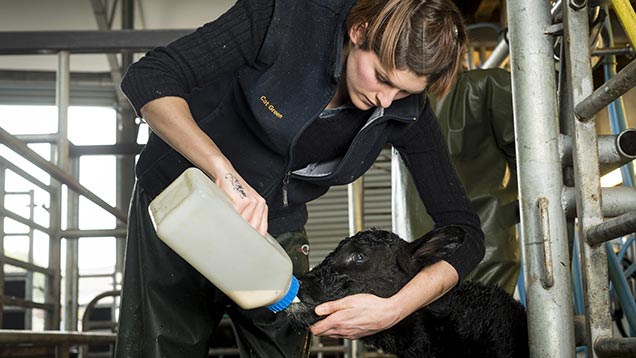5 steps to minimising coccidiosis
 © Jim Varney
© Jim Varney With the cost of replacement heifers escalating this season, minimising health challenges to dairy calves during the rearing phase is critical to avoid losses and maximise long-term productivity.
Any delay in a heifer’s ability to calve down by 24 months adds a significant cost of at least £50 a month a heifer, according to Oliver Tilling, vet at Shepton Veterinary Group in Somerset.
The parasitic disease coccidiosis is the second most common cause of diarrhoea in calves. Its effects on growth rates delay the onset of puberty and first service, adds Mr Tilling.
Read how one Scottish farmer has beat calf scours
“Whenever I am investigating a suspected case of coccidiosis, I always use this method (5 Cs) to develop a clear understanding of the farm and current practices.”
“Estimated losses of milk production can be up to 108 litres in their first lactation, so, any way we can help to reduce disease risks can contribute to meeting targets.”
The five Cs to supporting calf development and minimising the threat of coccidiosis:
1. Colostrum management
“Ideally we want to make sure that calves are receiving a source of colostrum that is rich in antibodies, whether this is directly from the cow, bottle or oesophageal feeder.
“Ensuring an intake of colostrum of at least 10% of the calf’s bodyweight ASAP after birth is essential. I usually advise farmers to give four litres within the first four hours after birth and a further four litres 12 hours later.
“This will ensure antibodies can be absorbed directly into the blood stream supporting the immune response against potential challenges.”
2 and 3. Cleanliness and comfort
Both factors can play a significant role in reducing the disease risk to young animals. “Wet and mucky conditions harbour disease, especially a disease such as coccidiosis,” says Mr Tilling.
The source of coccidiosis infection is through the ingestion of infectious oocysts passed in the faeces of other infected animals.
“The nature of these oocysts means that they are able to survive for long periods of time and are very resistant to disinfectants.
“By ensuring calves have access to clean, dry bedding from birth, farmers can reduce their level of exposure to the source of infection,” he says.
4. Calories
The quality and amount of feed calves have is important. The period between birth and weaning is the time when feed conversion efficiency is at its greatest.
“Providing a nutritionally balanced diet in sufficient quantities, will not only support growth and development but provides young stock with the resource to fight off potential challenges,” says Mr Tilling.
“We are not just feeding for growth; we are feeding the immune system.”
5. Consistency
Lastly, Mr Tilling highlights how the consistency of routine can help reduce a calf’s susceptibility to disease.
“Cows and calves thrive on consistency, which is why I always ask farmers when animals are fed, whether the same person is feeding, how feed is prepared, and how frequently they are bedded down to build the full picture.”
How to tackle coccidiosis
“If we suspect coccidiosis to be the main source of disease, the two key areas we usually find can be improved are colostrum management and cleanliness.
“But to confirm a coccidiosis infection, we also take faecal samples from calves showing the clinical signs of coccidiosis, such as scours, poor growth rates and a dull coat, and then we perform speciation testing,” he says.
“This allows us to identify the species of eimeria present, the parasite responsible for causing coccidiosis in cattle, for which there are multiple species, but only three that cause the disease in cattle.”
Mr Tilling explains that building a full picture means he can work with the farmer to recommend treatment and practical solutions to help combat coccidiosis, to reduce any detrimental impacts on calf development.
“The nature of coccidiosis means 95% of cases in calves are sub-clinical, and so when we see a calf sick with coccidiosis, this is just the tip of the iceberg.
“If we know that pathogenic coccidiosis is the cause of the issue, and we know the main trigger points when the disease is likely to take hold, such as grouping and weaning, we can develop a preventative programme which includes treating with Baycox (toltrazuril).
“Targeting treatment at the right time to ensure no clinical symptoms develop is possible once the full picture is known.
“Any animal that is compromised at an early age will struggle to fully recover. By addressing the issue and assessing the whole on-farm picture we can help reduce potential production losses and maximise economic return,” adds Mr Tilling.
